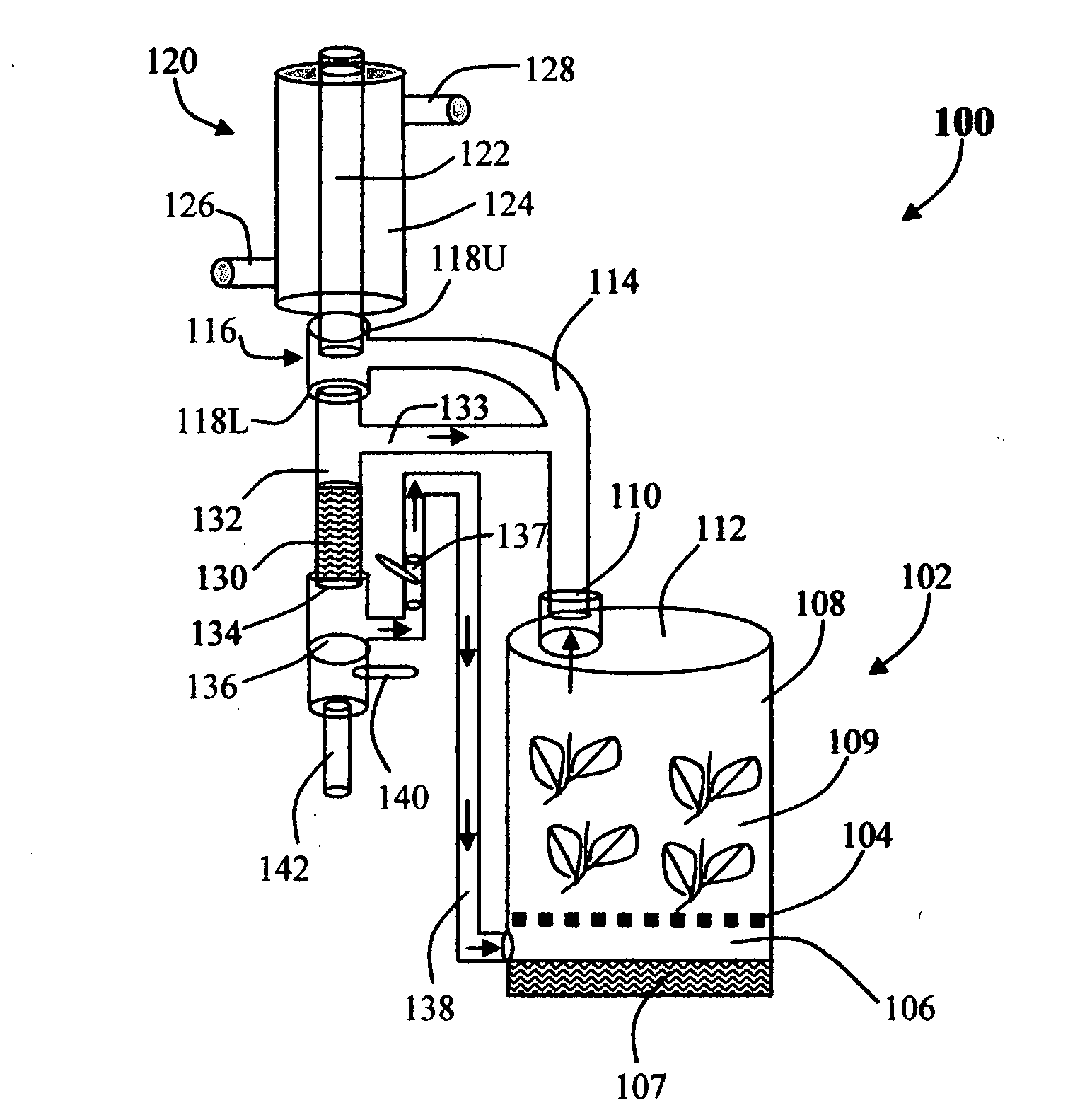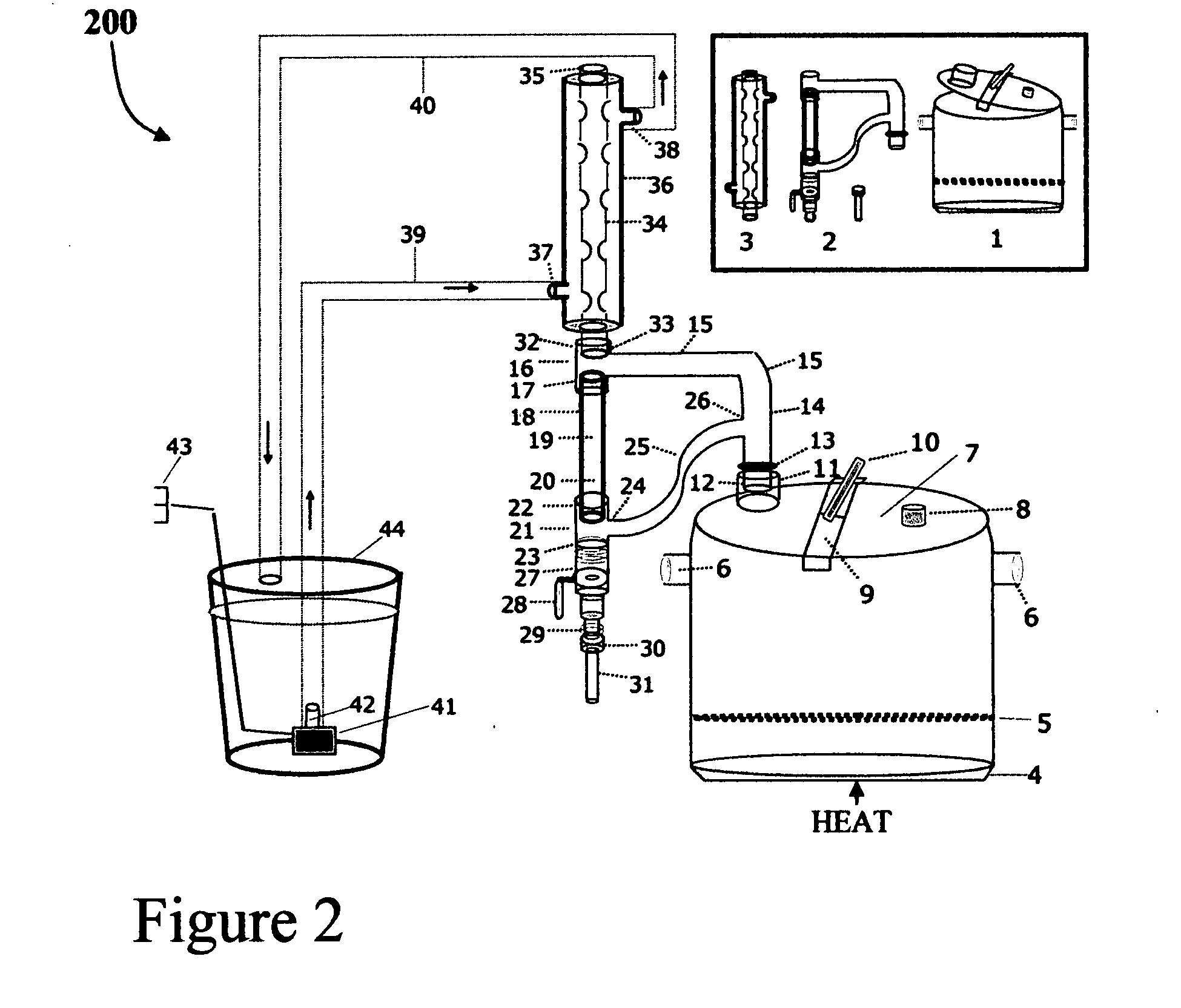Small and efficient distillation apparatus for extraction of essential oils from plant matter
a distillation apparatus and small technology, applied in the direction of chemistry apparatus and processes, solvent extraction, separation processes, etc., can solve the problems of hydro distillation, aromatic plant materials that cannot be extracted, and the type of distillation apparatus designed to distil, etc., to achieve convenient transportation, quick and efficient distillation, and simple operation
- Summary
- Abstract
- Description
- Claims
- Application Information
AI Technical Summary
Benefits of technology
Problems solved by technology
Method used
Image
Examples
example 1
[0078]The volatile oils yield obtained by steam distillation from 100, 300, 500, 700 and 900 gram fresh rosemary (Rosemarinus officinalis L) branches (leaves and soft stems) is described. In the beginning, 0.8 liter of fresh water was charged into the vessel (1). The branches were then placed on the grid (5) and covered with a dry cloth (100% cotton 30×30 cm) that serves as a filter for capturing small particles joining the steams during the distillation process. The distance between the grid and water level was 2.5 mm. The vessel was placed on electric stove at a constant level (Hamilton hot plate at a level 4) that produces about 12 ml / min flow rate of distillate. The vessel was closed by the lid (7) and then the inlet (12) of the reflux unit was inserted into the vessel's outlet (11). As shown in FIG. 2, a basic bucket of 10 liter volume was filled with 9 liter tap water and the water pump that sits inside the water bucket. After connecting the plastic pipe (39) between the water...
example 2
[0080]The experiment was done as described in example 1. 500 gram of each plant branches (geranium, rosemary and lavender) was taken to extract volatile oil by steam distillation. Their volatile oils yields were measured in a different condensation time intervals as indicated in Table 2. The results show that almost all volatile oil quantity was recovered after 35 min condensation time while extracting 500 gram fresh plant materials. Thus it is recommended to charge the apparatus with 500 gram fresh plant material while using a steam distillation.
TABLE 2Experimental data showing the yield of volatile oilsextracted by seam distillation from 500 gram fresh plantmaterial at different condensation time intervalsCondensationVolatile oil volume (ml)time* (min)geraniumrosemarylavender50.61.85.0101.02.97.0151.23.37.5201.43.87.7251.54.17.7301.54.47.7351.54.67.7*A longer condensation time of 70 min was done for each sample and the volatile oil yield considered as a maximum yield. The calculat...
example 3
[0081]The experiment was done as described in example 1, but in addition, a dry cloth (100% cotton 40×40 cm) was set down on top of the grid (5), and the dried powdered plant material then placed on the cloth and spread homogenously on the entire top surface of the grid.
[0082]The yield of volatile oils was extracted from various quantities: 40, 120, 200 and 500 gram dried powdered cardamom, and the volatile oil amount at different condensation time intervals was measured and presented in Table 3. The results indicate that a dried powdered plant material (cardamom fruits seeds) gives the highest volatile oil production, while charging the apparatus with 40 and 120 gram and running during 35 min condensation time. Thus, to obtain an optimal yield, it is recommended to charge the apparatus with about 120 gram dried plant material while using a steam distillation method. While extracting dried plant materials, it is recommended to limit the plant quantity up to 500 gram, as the dried pl...
PUM
| Property | Measurement | Unit |
|---|---|---|
| diameter | aaaaa | aaaaa |
| diameter | aaaaa | aaaaa |
| height | aaaaa | aaaaa |
Abstract
Description
Claims
Application Information
 Login to View More
Login to View More - R&D
- Intellectual Property
- Life Sciences
- Materials
- Tech Scout
- Unparalleled Data Quality
- Higher Quality Content
- 60% Fewer Hallucinations
Browse by: Latest US Patents, China's latest patents, Technical Efficacy Thesaurus, Application Domain, Technology Topic, Popular Technical Reports.
© 2025 PatSnap. All rights reserved.Legal|Privacy policy|Modern Slavery Act Transparency Statement|Sitemap|About US| Contact US: help@patsnap.com



